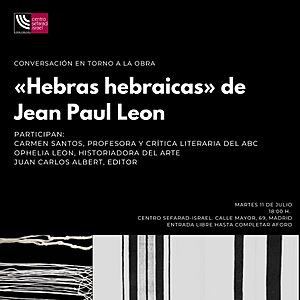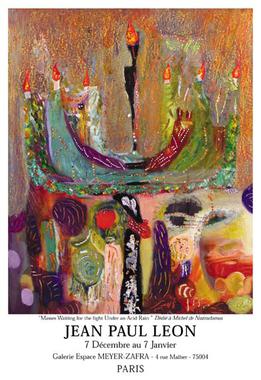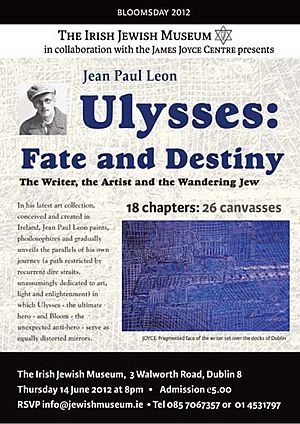Jean Paul Leon facts for kids
Jean Paul Leon (born 1955) is a talented French and Spanish artist, sculptor, and writer. He is best known for his big project called Unison. This project brings together four art collections that explore major world religions and philosophies, like Christianity, Judaism, Islam, Buddhism, and Daoism. His goal with Unison is to encourage understanding and friendly talks among people from all backgrounds.
One of his important books is Heritage, which was the first in a series of three. It was praised by French Minister Jack Lang and recommended by a curator from the famous Louvre Museum. He also released Hebras hebraicas, a book of short stories and paintings of the Menorah, which is a special candelabrum.
In 2020, he published Mujeres en la Cruz (Women on the Cross). His paintings with the same title were shown at the Fundación Antonio Berni. These artworks helped inspire workshops and a digital museum called Art4WomensRights.com. This project, supported by the International Council of Museums (ICOM), uses art to raise awareness about important issues affecting women around the world.
His most recent book, La palabra desnuda (The Naked Word), was presented in November 2023. Also, a large 4-meter-long mural by Jean Paul Leon Yodh, called Da Vinci's Dream or the Nightmare of the 4 Judges, was unveiled at the Hospital Clínic de Barcelona in February 2024. This mural marked two years since he received a kidney transplant from his wife.
Contents
Early Life and Education
Jean Paul Leon grew up in both France and Spain. He studied classic subjects like Greek and Latin in England. When he was just seven years old, he met the famous artist Pablo Ruíz Picasso. Meeting Picasso and visiting his art studio had a huge and lasting effect on young Jean Paul. At age 11, he won a national writing contest sponsored by Coca-Cola, showing his writing talent early on.
Jean Paul Leon as a Writer
By the time he was 16, Jean Paul Leon had already published his first article in the newspaper El Norte de Castilla. He was guided by the respected writer Miguel Delibes and later became a regular writer for the newspaper. At 19, he started writing for Triunfo magazine, where he published in-depth interviews with English folk singers. His short story, The Last Judgement, was published in 2015 to help Doctors Without Borders.
After spending 12 years writing in Hollywood, he returned to writing and publishing in Spanish. He has released four new books in the last four years. A literary critic, Concha D'Olhaberriague, described his writing style as "avant-garde" and full of "Jewish humor," satire, and wit.
His Artistic Career
When he was 23, Jean Paul Leon moved to New York City. At his very first art show there, he was named the 'most promising young artist' at the Washington Square Outdoor Art Exhibit. A year later, at 24, he had his first solo art show on Madison Avenue in New York. He continued to exhibit his art until the 1990s, when he moved to Hollywood to work in the film and animation industry.
In 2003, after 12 years in Los Angeles, he moved back to Paris. There, he started exhibiting his art again and continued his lifelong focus on the theme of "Light and Luminaries" – exploring how important figures and ideas contribute to global culture.
The Heritage Collection
In 2006, Jean Paul Leon's art, which included 30 years of work on the Menorah as a symbol of light, was put together in an art book called Héritage. This book was praised by French Minister Jack Lang and recommended by a curator from The Louvre Museum. The book combined his paintings and writings in three languages. It was supported by the Culture Mission of La Fondation pour la Mémoire de la Shoah in Paris, which was led by Simone Veil, a survivor of the Bergen-Belsen and the first woman President of the European Parliament. A writer for the Smithsonian magazine described his work as having "incandescent energy" that offers "unexpected revelations."
Menorah in the Cathedral Exhibit
In 2005-2006, the Heritage Collection was shown at the Cathedral of Brussels by the Jewish Museum of Belgium. This exhibit, called “Menorah in the Cathedral,” aimed to address the pain and disagreements between the Christian and Jewish communities. It led to a historic meeting between the two groups. The Archbishop of Brussels, Jozef De Kesel, even apologized for past wrongs committed against Jews in Brussels in 1370. This event was an important step in bringing together the artist's works that would later form The Unison Collection.
I.N.R.I. and Ulysses, Fate & Destiny
During this time, Jean Paul Leon also began a new collection called I.N.R.I.. These were 33 powerful portraits of Jesus Christ, painted on large crosses. These artworks explored how the image of Jesus has been seen and understood over the last 2000 years. The famous British writer Philip Pullman described these pictures as a "formidable attempt to grapple with the legacy of the most strange and enigmatic man who ever lived."
In 2007, Jean Paul Leon moved his studio to Dublin. There, he created Ulysses, Fate and Destiny. This art collection illustrated the 18 chapters of James Joyce's famous novel, Ulysses (novel). It explored the character of Leopold Bloom as a symbol of the "wandering Jew" and Homer's Odysseus as a hero facing many dangers on his journey home.
Reflections of Islam and The Unison Collection
After finishing his work in Dublin, Jean Paul Leon settled in Berlin. He then focused on a collection he had started much earlier, called Reflections of Islam. He began this work in 1978 and continued it in 1991. Much of this art was created in the Sonoran Desert, Arizona, using 3D objects and mirrors. These mirrors reflect the viewer, making them part of the artwork. This collection is inspired by readings from the Qur'an, contemplation, the desert landscape, and his love for calligraphy.
The three collections: Hebrew Heritage, I.N.R.I., and Reflections of Islam, along with Oriental Meditations, make up The Unison Collection. This collection shows Jean Paul Leon's lifelong dedication to the idea that when people explore different religions, they often find common ground and understanding. A leading art appraiser from Paris, Maître Pierre Cornette de St-Cyr, noted that Jean Paul Leon's art uses light to guide us towards greater understanding.
Images for kids
See also
 In Spanish: Jean Paul Leon para niños
In Spanish: Jean Paul Leon para niños




